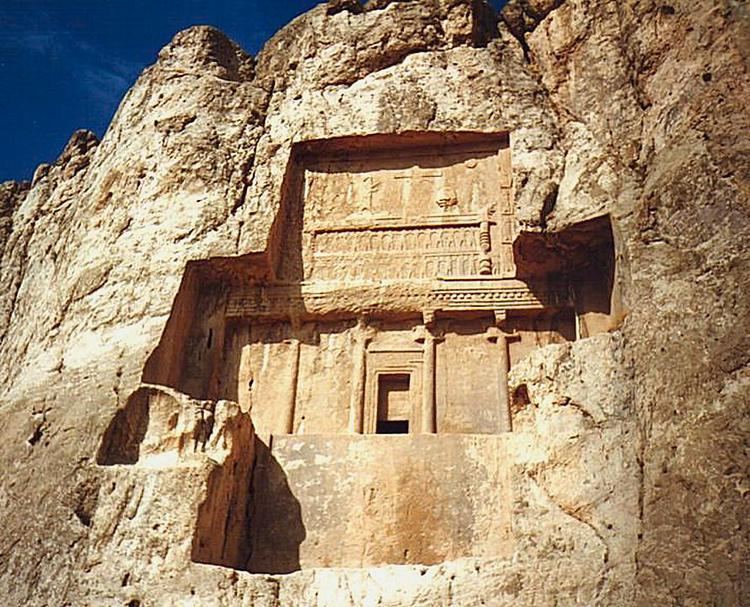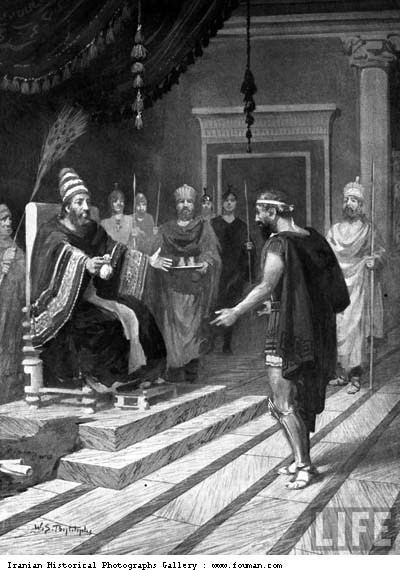Reign 465–424 BC House Achaemenid Parents Xerxes I, Amestris Burial Naqsh-e Rustam, Persia Died 424 BC, Susa | Successor Xerxes II Role King Predecessor Xerxes I Name Artaxerxes of | |
 | ||
Spouse Queen Damaspia
Alogyne of Babylon
Cosmartidene of Babylon
Andia of Babylon Children Darius II, Xerxes II of Persia, Sogdianus of Persia, Parysatis Grandchildren Artaxerxes II of Persia, Cyrus the Younger Cousins Darius III, Mardonius, Hystaspes, Artaynte, Nabugu Similar People Xerxes I, Darius II, Artaxerxes II of Persia, Darius I, Darius III | ||
Grandparents Darius I, Atossa, Otanes | ||
Artaxerxes I of Persia
Artaxerxes I (Persian: اردشیر یکم, Old Persian: Artaxšaça, "whose rule (xšaça < *xšaϑram) is through arta (truth)"; Hebrew: אַרְתַּחְשַׁשְׂתָּא ; Greek: Ἀρταξέρξης) was the fifth King of Persia from 465 BC to 424 BC. He was the third son of Xerxes I.
Contents
- Artaxerxes I of Persia
- Succession to the throne
- Egyptian revolt
- Relations with Greece
- Portrayal in the Book of Ezra and Nehemiah
- Interpretations of actions
- Medical analysis
- Issue
- References

He may have been the "Artasyrus" mentioned by Herodotus as being a Satrap of the royal satrapy of Bactria.

In Greek sources he is also surnamed "long-handed" (μακρόχειρ Macrocheir; Latin: Longimanus), allegedly because his right hand was longer than his left.

Succession to the throne

Artaxerxes was probably born in the reign of his grandfather Darius I, to the emperor's son and heir, Xerxes I. In 465 BC, Xerxes I was murdered by Artabanus, the commander of the royal bodyguard and the most powerful official in the Persian court (Hazarapat/commander of thousand), with the help of a eunuch, Aspamitres. Greek historians give contradicting accounts of events. According to Ctesias (in Persica 20), Artabanus then accused the Crown Prince Darius, Xerxes's eldest son, of the murder and persuaded Artaxerxes, to avenge the patricide by killing Darius. But according to Aristotle (in Politics 5.1311b), Artabanus killed Darius first and then killed Xerxes. After Artaxerxes discovered the murder, he killed Artabanus and his sons.
Egyptian revolt

He had to face a revolt in Egypt in 460–454 BC led by Inaros II, who was the son of a Libyan prince named Psamtik, presumably of the old Saite line. In 460 BC, Inaros II revolted against the Persians with the help of his Athenian allies, and defeated the Persian army commanded by satrap Akheimenes. The Persians retreated to Memphis, and the Athenians were finally defeated in 454 BC, by the Persian army led by Megabyzus, after a two-year siege. Inaros was captured and carried away to Susa.
Relations with Greece
After Persia had been defeated at Eurymedon (ca. 469 BC), military action between Greece and Persia was at a standstill. When Artaxerxes I took power, he introduced a new Persian strategy of weakening the Athenians by funding their enemies in Greece. This indirectly caused the Athenians to move the treasury of the Delian League from the island of Delos to the Athenian acropolis. This funding practice inevitably prompted renewed fighting in 450 BC, where the Greeks attacked at the Battle of Cyprus. After Cimon's failure to attain much in this expedition, the Peace of Callias was agreed among Athens, Argos and Persia in 449 BC.
Artaxerxes I offered asylum to Themistocles, who was probably his father Xerxes's greatest enemy for his victory at the Battle of Salamis, after Themistocles was ostracized from Athens. Also, Artaxerxes I gave him Magnesia, Myus, and Lampsacus to maintain him in bread, meat, and wine. In addition, Artaxerxes I gave him Palaescepsis to provide him with clothes, and he also gave him Percote with bedding for his house. Themistocles would go on to learn and adopt Persian customs, Persian language, and traditions.
Portrayal in the Book of Ezra and Nehemiah
Artaxerxes (Hebrew: אַרְתַּחְשַׁשְׂתְּא, pronounced [artaχʃast]) is described in the Bible as having commissioned Ezra, a Jewish priest (kohen) and scribe, by means of a letter of decree (see Cyrus's edict), to take charge of the ecclesiastical and civil affairs of the Jewish nation.
Ezra thereby left Babylon in the first month of the seventh year of Artaxerxes' reign, at the head of a company of Jews that included priests and Levites. They arrived in Jerusalem on the first day of the fifth month of the seventh year (Hebrew Calendar).
The rebuilding of the Jewish community in Jerusalem had begun under Cyrus the Great, who had permitted Jews held captive in Babylon to return to Jerusalem and rebuild the Temple of Solomon. Consequently, a number of Jews returned to Jerusalem in 538 BC, and the foundation of this "Second Temple" was laid in 536 BC, in the second year of their return (Ezra 3:8). After a period of strife, the temple was finally completed in the sixth year of Darius, 516 BC (Ezra 6:15).
In Artaxerxes' 21st year (445 BC), Nehemiah, the king's cupbearer, apparently was also a friend of the king as in that year Artaxerxes inquired after Nehemiah's sadness. Nehemiah related to him the plight of the Jewish people and that the city of Jerusalem was undefended. The king sent Nehemiah to Jerusalem with letters of safe passage to the governors in Trans-Euphrates, and to Asaph, keeper of the royal forests, to make beams for the citadel by the Temple and to rebuild the city walls.
Interpretations of actions
Roger Williams, a 17th-century Christian minister and founder of Rhode Island, interpreted several passages in the Old and New Testament to support limiting government interference in religious matters. Williams published The Bloudy Tenent of Persecution, arguing for a separation of church and state based on biblical reasoning. Williams believed that Israel was a unique covenant kingdom and not an appropriate model for New Testament Christians who believed that the Old Testament covenant had been fulfilled. Therefore, the more informative Old Testament examples of civil government were "good" non-covenant kings such as Artaxerxes, who tolerated the Jews and did not insist that they follow his state religion.
Medical analysis
According to a paper published in 2011, the discrepancy in Artaxerxes’ limb lengths may have arisen as a result of the inherited disease neurofibromatosis.
Issue
By queen Damaspia
By Alogyne of Babylon
By Cosmartidene of Babylon
By Andia of Babylon
By another(?) unknown wife
By various wives
